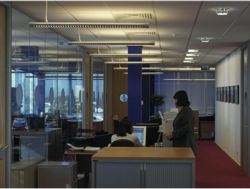Delivering energy-efficient lighting

The latest lighting technology can cut the running cost of fluorescent lighting by 30% compared with installations as little as five years old.
HUGH KING discusses the newly emerging sense of commercial reality with energy-efficient lighting.Two or three years ago energy-saving lighting gave people a warm glow. Now, as electricity costs soar, it is highly commercial. If it saves money people will do it. If not, they won’t — even if they think it might be saving money for the nation or whatever. The good news is that immediate energy savings up to 70% are possible at low capital cost by eliminating less efficient lamps. New technology cuts the running cost of fluorescent lighting by 30% compared with installations as little as five years old. Energy-effective lighting gives you the same lighting result at typically 30 to 70% lower electricity cost than yesterday’s technology. This is because whilst lighting may consume only 16% of total electricity consumption in the UK, in public buildings and offices it accounts for about 50%! This article shows you how to access the energy efficiency of the lighting in your building by making simple checks, how to go about a lighting energy audit and where to get help and advice. First, how do you recognise waste? The table lists what to look for, what you should do and how you could benefit.
Design factors If the table has helped identify some possibilities, remember that the design of lighting installations to a given standard, but with minimum energy use requires attention to six key design factors. • Use the most efficient light sources suitable. • Effective use of lamp light output (luminaire performance). • Good maintenance. • Design the lighting scheme for people, rather than areas. You would not, for example, feel too good about having an operation if you heard that lighting levels in the theatre had been reduced to save energy! • Control of switching operation and installation usage. • Take account of the effect of surrounding décor.
Qualitative v quantitative Carrying out an energy audit on your lighting will show whether you are getting value-for-money, in terms of the lighting you get out compared with the electricity costs you incur. The table shows the qualitative approach — simply looking at your lighting to identify the use of obsolete or inefficient products. You can also conduct a quantitative energy audit by calculating the average efficiency for the building. Indeed the Building Regulations for England & Wales (Part L) require you to do this for all new and refurbished non-domestic buildings with over 100 m2 of floor area. Lighting manufacturers should be able to guide you with the necessary figures — such as luminaire lumens/circuit watt. Calculating figures for your current lighting will show if you have a significant opportunity for action to save on energy costs. Simply compare the results against the guidelines in Part L. Mention of the political arena brings us to energy policy. In addition to Part L is the Enhanced Capital Allowances (ECA) scheme, which enables businesses to claim 100% first-year capital allowances on investments in energy-saving equipment. Businesses can write off the whole cost of their investment against their taxable profit of the period during which they make the investment. However, readers are recommended to check with their local tax office first to see if the scheme in question applies. For instance, general office lighting may not qualify, but a change of use such as converting a warehouse to offices may. Additionally a new EC directive (2000/55/EC) is improving energy-efficient requirements for ballasts for fluorescent lighting. This effectively bans inefficient types of ballast and encourages the lighting industry to use high-frequency electronic versions. It is expected that in five years 70 to 75% of fluorescent fittings will be operated by electronic ballasts. You can make lighting use energy efficiently and effectively. All it takes is a willingness to use good design.

A simple visual inspection of your lighting installation can easily identify opportunities for very cost effective refurbishment.
Help from the experts. Expert advice is readily available. The most useful sources of advice are the following. • UK Lighting Industry Federation (trade body) www.lif.co.uk • Society of Light & Lighting (code of practice) www.cibse.org • Building Regulations Part L www.odpm.gov.uk/bregs • Enhanced Capital Allowances www.eca.gov.uk • International Association for Energy Efficient Lighting www.iaeel.org
Hugh King is with Thorn Lighting, 3 King George Close, Eastern Avenue West, Romford, Essex RM7 7PP.
Related links:




